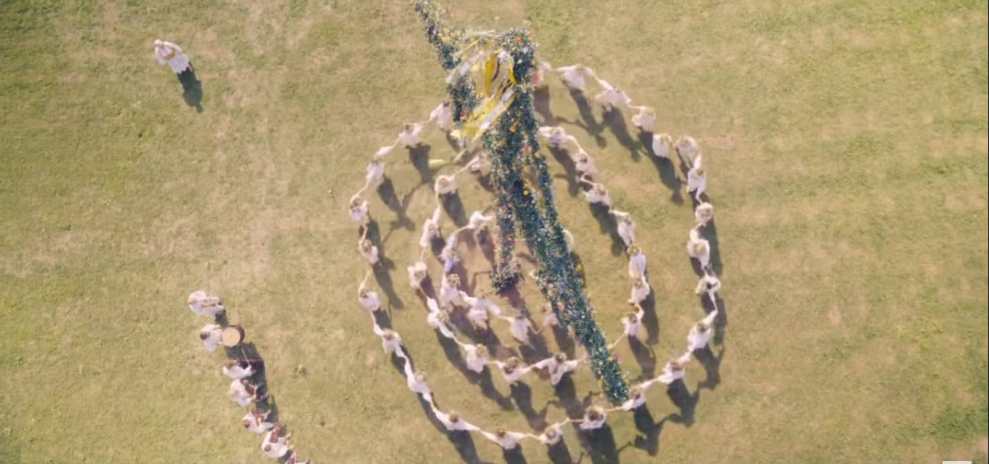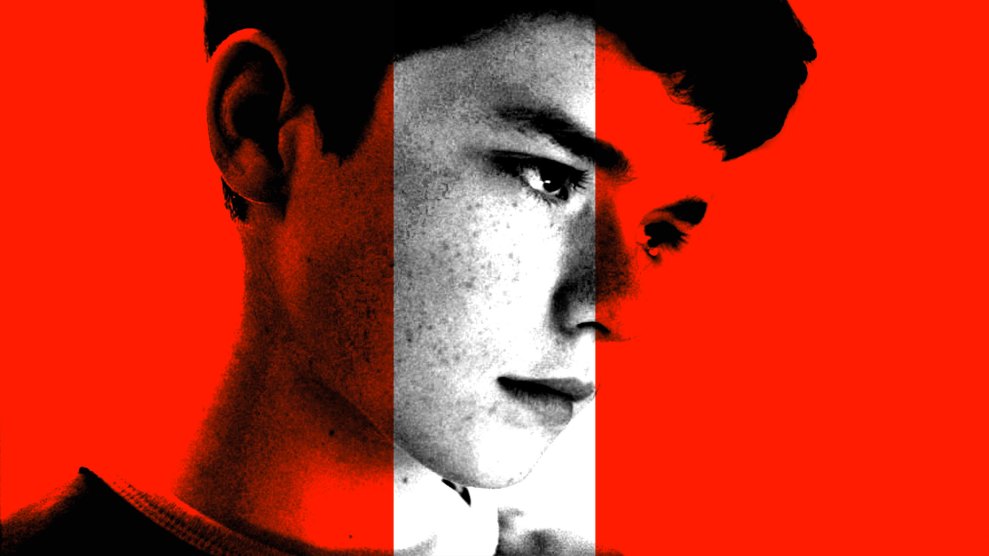
A24 Films
Like all good human sacrifice stories, Midsommar asks that simple, time-honored question: What happens when you realize you’re not just an individual—filled with hopes and fears and your own unique personality—you’re also a thing, just some meat for the pyre?
Ari Aster’s film begins in winter, a foreboding snowy night when Dani Ardor (Florence Pugh) learns that her sister has killed herself and their parents in a murder-suicide. All she’s left with is her feckless boyfriend Christian (Jack Reynor), who’s already been looking for a way to break up with her for months. Christian, an anthropology student, is secretly planning a trip to Sweden to his friend Pelle’s (Vilhelm Blomgren) hometown, Hårga, to witness the town’s once-in-90-years midsommar ceremony with some other students, but Dani gets wind of it and invites herself along. Pelle’s brother has brought along two friends of his own, an engaged couple from London. A fun time is promised to all.
The village seems nice at first, with lots of cheery-but-also-ominous pagan imagery woven into the bucolic Swedish landscape. Murals and tapestries depict lots of magic spells involving pubic hair and blood and also maybe a tad bit of ritual sacrifice of some kind. The pace of Midsommar’s first half is glacial; like Ti West’s The House of the Devil, much of the tension requires the audience remembering that it’s a horror movie, and thus something bad is bound to happen at any moment. In the absence of anything overtly frightening, everything bends sinister. What’s in that spooky yellow house at the edge of town? What’s with the bear in the cage? What’s really in the meat pie?
Everything changes with a sudden and very graphic ritual that horrifies the outsiders, but even so, no one’s in real danger yet. The film doesn’t rely on jump scares (though there is some literal jumping, and it’s a little scary); rather, the terror comes from the growing realization that some people simply value things differently from the rest of us, in a way that starts out charming and moves inexorably first to unsettling and then to terrifying.
Along with 2015’s The Witch, Midsommar is part of a rebirth of a genre known as “folk horror,” a term with early antecedents but which entered the popular lexicon after Piers Haggard used it in 2003 to describe his 1971 film Blood on Satan’s Claw. Primarily, the genre was birthed with a trilogy of British films from the late 1960s and early 1970s: Blood, Witchfinder General (1968), and The Wicker Man (1973). The key elements of folk horror are a strange and unfamiliar landscape, an isolated community that has adopted a skewed belief system, and an unexpected violence that gradually erupts as a result of that skewed morality.
Folk horror involves a kind of cultural inbreeding—an isolated community, without the normal exchange of ideas and morality, develops its own set of values, perverse and inverted. And while all folk horror films borrow from this template, The Wicker Man remains the clearest embodiment of all of these elements, and it is to The Wicker Man that Midsommar owes its clearest allegiance.
It’s a durable genre because here the villain is not a guy in a hockey mask, but rather a whole town of happy people, all serene and smiling even as you go to your own death. In the standard horror film, a Halloween or a Texas Chainsaw Massacre, the protagonists’ lives are what’s on the chopping block. In folk horror, the flesh and blood are secondary—what’s really at stake are the values by which we live.
Midsommar lands as the right is once again attempting to foment terror around the word “socialism,” trying to convince us that the only good virtue is selfish individualism. Folk horror’s allure is in tapping directly into this anxiety, offering a radical version of giving yourself over to the collective. As Fox News nightly trots out center-left policy proposals as examples of socialist horror, films like Midsommar are the reductio ad absurdum version of this. You want socialist horror? Okay, here you go. What if you were trapped in a town full of people who simply didn’t think the way you do? What happens when you’re confronted with a group of people who value something greater than their own lives, or something greater than your own life?
More so than other folk horror films, Midsommar is concerned with exactly how such isolated, skewed communities work. Because Christian and his friends are anthropology students (William Jackson Harper’s Josh is explicitly doing his thesis on midsummer rituals), there’s lots of diegetic space for them to ask questions in the guise of field work, offering an in-depth look at Pelle’s little commune town. Among other things, we learn that everyone sleeps in communal barracks, and that “family” is not a biological or nuclear affair but a community project. The bloodlines are monitored to prevent incest, but there are deliberate exceptions: the village’s oracle, Ruben, is the product of inbreeding, supposedly the source of his insights. Above all, to be a member of Hårga is to let go of your individual needs in favor of the community, to dissolve your identity into the larger identity of the village. Everybody pitches in to help, a devotion that involves a little sacrifice on everyone’s part.
Midsommar ultimately lacks the puzzle-perfect logic of The Wicker Man, and a lot of questions go unanswered by the film’s end. But it fulfills the terms it sets for itself. And when the murders finally start, they happen by and large off-screen—the film is not about titillating its audience via vicarious sadism. The film treats death the same way its characters do: neither to be avoided nor sensationalized.
Aster has said that it’s a break-up film inside a horror film, and it is that, but it’s also a meditation on grief, as Dani’s trip to Hårga becomes increasingly about understanding what it means to have a family and what it means to lose a family. In grief, Dani has lost core pieces of her identity: her status as a sister, as a daughter, and as a caretaker. Her status as Christian’s girlfriend is hanging by a thread, as evidenced by every time he watches a Swedish girl go by. Her grief in freefall, her identity threatens to disappear altogether—tripping on psilocybin soon after arriving in Hårga, she sees grass growing up through her feet, as though she’s dissolving entirely into the landscape.
But this, after all, is the secret premise of folk horror: What if you just give up and give yourself over to the collective? What if you give up on your identity and your ego altogether? What, then, might be possible?
It’s a lot to take in for Dani and her friends, who struggle against these ideas—first existentially, and then mortally. But Hårga makes a compelling case. In other folk horror films, the killing often seems extraneous, or at least tied to a magic with dubious outcomes. Burning Sergeant Howie, after all, is not going to bring your apples back. The Wicker Man’s Summerisle turns to sacrifice out of desperation and superstition, but Hårga seems a pretty high-functioning little cult, running on a moral logic that, while not exactly sound, at least forces the Americans into conflict with their assumptions.
If Midsommar is ultimately disturbing, it’s because the film has so little interest in apologizing for its critique of Western individualism. The argument given by the elder Siv in favor of senicide, for example, is a moving, eloquent meditation on embracing life instead of trying to prolong it endlessly. The refusal to apologize is Midsommar’s real horror—a placid, unblinking stare that cuts more deeply than any chainsaw.
Colin Dickey is the author, most recently, of Ghostland: An American History in Haunted Places (Viking), as well as Cranioklepty: Grave Robbing and the Search for Genius and Afterlives of the Saints: Stories from the Ends of Faith.












